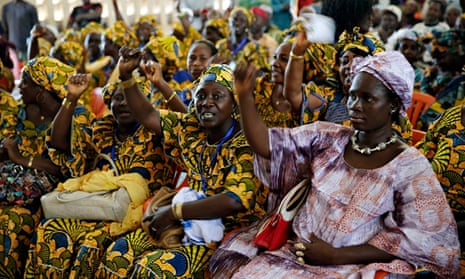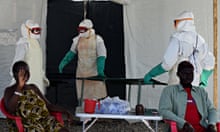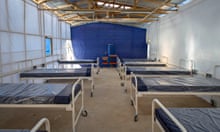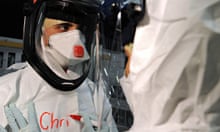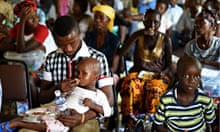In a clearing deep in Guinea’s hilly interior, a World Food Programme (WFP) worker surveys a tropical downpour that has brought everything to a standstill and reflects on the hardest part of his work. His job is to transform this disused, battered airstrip in remote Kissidougou into a major logistics base for Ebola efforts, but the biggest challenge is one that’s constant and ultimately has no fix.
“We’re in a situation that goes against human instinct – it’s difficult to go every day without even shaking hands with people you’re working with,” says the WFP logistician, whom we have been asked not to name, of the no touching rule designed to stop Ebola contagion.
But adapting has become second nature for those responding to a situation unprecedented in modern times. After a belated influx of international aid, operating manuals are being updated by organisations scrambling to stem an outbreak. With the death toll across Guinea, Liberia and Sierra Leone topping 5,000 this month, everything from equipment to medical trials to psychology handbooks is being tested, upgraded and refashioned.
The crisis has pushed the WFP, the world’s largest humanitarian organisation, into uncharted territory: instead of constructing the warehouses that come with delivering several tonnes of food aid to 80 million people annually, its engineers are building four Ebola treatment centres due to open this month across Guinea.
“For the WFP that’s a first – there aren’t many Ebola treatment centres around,” Alex Marianelli, the country logistics director, notes at the agency’s headquarters in the capital, Conakry, where plans detailed the layout of an Ebola treatment centre. The blueprints are designed by MSF, the medical organisation leading treatment efforts, which has shared them with other organisations for the first time.
This year, 150 trees were cut down in Sierra Leone’s Kailahun district to make a 50-bed Ebola treatment centre, at the time MSF’s biggest ever. Those efforts have since been dwarfed by the expanding crisis: the organisation now runs a 250-bed unit in Liberia; and in Guinea almost a dozen more centres are due to open before the year ends.
From the air, miles of green, mist-topped hills form the stunning topography of Forestiere region, where the outbreak began almost a year ago. On the ground, the elephant grass grows the height of a man, hiding hundreds of footpaths that lead to villages which health workers may need to reach. The remoteness of some villages may have allowed them to escape the spiralling epidemic.
“Our response was too orientated toward the management of previous outbreaks,” Jean-Herve Bradol, a member of MSF’s internal thinktank, told Reuters this month. He said the emergency group’s reliance on strategies during smaller, previous eruptions of the virus led to mistakes.
This time, the scale of the epidemic has forced rapid innovation. “The amount of chlorine being sprayed – it was just causing the [isolation] tents to disintegrate,” Marianelli says. Back at MSF’s headquarters in Brussels, a team is developing field tents that prevent overheating in the exhausting tropical heat, and gumboots that dry fast as they are also regularly sprayed down with chlorine. Bodybags that soak up highly-infectious fluids in corpses are also being designed.
Even incinerators, used to burn any potentially infectious material at treatment centres, had to be switched to new models a few months into the crisis. “Each time a health worker goes into the isolation tents and comes out, their [protective] suit has to be burnt. So they’re on all the time,” an MSF worker said at the Conakry unit, surveying the plumes of smoke.
Many of the new centres set to open in coming months will be supplied by WFP logistics bases in places so remote only propeller planes can land. “That aircraft landing strip,” the WFP logistician explains, pointing towards a thread of red earth snaking through the elephant grass, “needs to be equipped so that C10 and military aircraft can land here.”
“When the calls started coming in, many qualified people were saying they were busy or were just not replying” to requests to come out here, the WFP workers says, sitting in an office furnished with only a plastic desk, stacks of flat pack shelves and a printer with no electric socket to power it.
But in some ways, Guinea is well-placed to respond to the crisis. Like its neighbours Liberia and Sierra Leone, mineral-rich hills have long attracted mining giants such as Rio Tinto and Arcelor Mittal. “What we find is there is a lot of stagnant activity which would usually be engaged on import-export mining operations. So, for example, the commercial sector has enough trucks to service the requirements of the Ebola response,” says Marianelli.
The challenge, he points out, is “how many trucks will we need next week? I can’t tell you that because this is an evolving situation.”
And the influx of aid has brought problems. France’s president, François Hollande, was one of the first to respond to a Guinean government appeal for more help, announcing in September that the French military would build and run a hospital in the epicentre of the outbreak. But deep suspicion about the former colonial power forced Guinea’s defence minister, Kabélé Camara, to bat away accusations the proposed hospital could be a way for Paris to eventually set up a military base. The centres will now be run by NGOs, with support from the military.
Others are trying to ensure that what is learned trickles down in a country languishing at the bottom of development indexes. “Our role is not to do everything, but to teach local staff how to do it,” said one aid worker.
